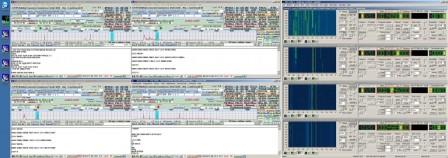Mult-channel SDR receiver
I’ve already published some posts on the multi-channel decoder capability of the Quadrus SDR fairly recently. However, I ended up doing some new tests with the MULTIPSK decoder, because some questions were raised.
As we’ve described it already, the DRU-244A based Quadrus SDR platform has multi-channel capability. It can be used to deliver up to 16 channels to the decoder system. Thus, it can be used very well in a production environment too.
http://spectrafold.hu/quadrus/digitizer-hardware/coherent-multi-channel-sdr-receiver/
MULTIPSK decoder software
This software stack was developed and is maintained by Patrick, F6CTE, and can be used to run different digital modes in the RF bands. In the SWL and UDX operation modes, we can use its receiver decoder capability. It contains a lot of HAM radio and professional digital modes, as you can see below.
Some of them are available in the free version, and some of the professional functionality is only available in the licensed version, which has a reasonable price.
http://f6cte.free.fr/index_anglais.htm
Connecting Quadrus multi-channel SDR and MULTIPSK decoders
The easiest and most convenient way to build a multi-channel SDR production system is by using virtual audio cables (VACs) to connect the audio output of the Quadrus multi-channel SDR to the decoder software. In case we’d like to use the full capacity of the receiver, we need some cables and some instance of the decoder running on the computer. To do that I just needed to understand the audio settings of the decoder software. After a short email exchange with Patrick, I understood that the MULTIPSK stores the audio and other settings in config files located in the program folder of the application. So, I just needed to make four different copies of the program in four different folders, and set up the audio input to the different VACs accordingly. I’ve made shortcuts on my desktop too. I assigned the VAC 1..4 to the four channels of my receiver, and I used the same set up with the decoder too.
Testing multi-channel SDR production system
I tuned to the different frequencies – used by meteo stations from Hamburg – as follows: DDK2 4583 kHz, DDH7 7646 kHz, DDK9 10100.8 kHz.
http://www.dwd.de/bvbw/generator/DWDWWW/Content/Schifffahrt/Sendeplan/Schedule__rtty__01,templateId=raw,property=publicationFile.pdf/Schedule_rtty_01.pdf
Then I tuned the fourth channel to the 20 m amateur band. As you can see from the receiver screen, the reception in the late morning time is pretty poor at 4.5 MHz, however, the upper bands have strong signals. At the output screen of the decoder, we can see the meteo messages and the ham radio calls in the 20 m band.
Conclusion
If your decoder software has the capability to run multiple instances at the same time on the same computer, you can integrate a very powerful multi-channel SDR production system. The connections between the receiver and the different decoder software can be implemented as virtual audio cables.




